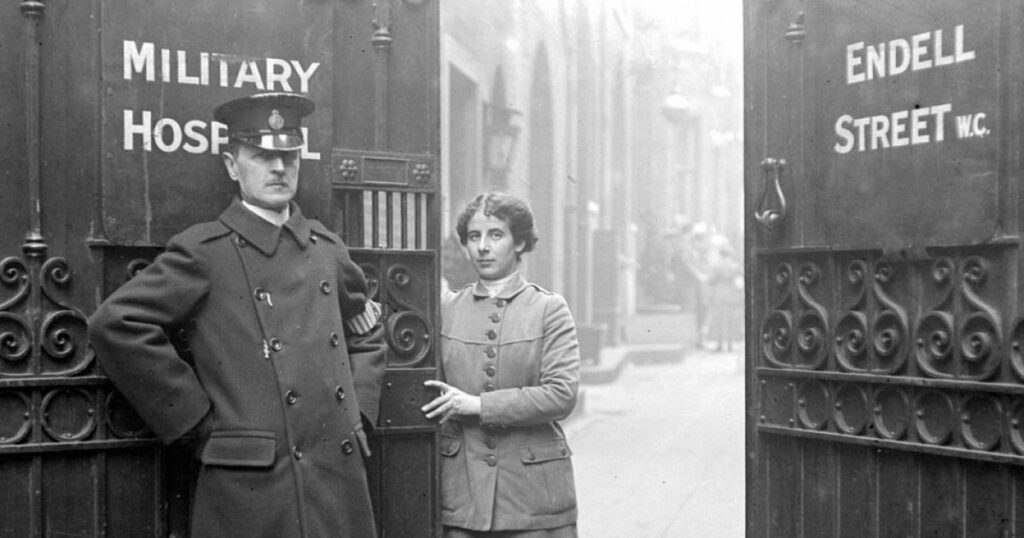Run by voluntary organisations such as the Red Cross, they relieved the pressure on the larger hospitals that received casualties directly from the front, by taking over less serious cases and those needing longer convalescence.
Two auxiliary hospitals, one in Islington and one in Hornsey, were located within half a mile of each other in the Crouch Hill area.

Park House was one of several large Victorian villas in Holly Park, a turning off Crouch Hill.
On December 9, 1915, it opened as Holly Park Auxiliary Military Hospital, attached to the Endell Street Military Hospital in Covent Garden. It had an operating theatre and five wards with 36 beds initially, rising to 42 by 1917.
Hornsey Auxiliary Military Hospital, attached to the Edmonton Military Hospital, was based in another Victorian villa, Durham House, formerly a school.
The hospital opened on June 24, 1916, with 72 beds in eight wards. Its medical officer was Dr Howard Davies.
Miss Mary Bassett Popkin, divisional secretary for the Islington Division of the British Red Cross Society, combined the roles of matron and commandant at the Holly Park hospital.
She was honoured for her work in October 1917, becoming an Associate (Second Class) of the Royal Red Cross. On June 1, 1918, she received the award from King George V at Buckingham Palace.
Holly Park’s consulting surgeon, Mr Alwyne Compton of 3 Mount View Road, attended the hospital ‘as required’.
Five other local doctors served as part-time medical officers, including Dr John Cameron Smith of 113 Crouch Hill, who worked eight hours a week attending patients and administering anaesthesia at operations.
Most of the nursing staff were not professionally qualified nurses but members of the Voluntary Aid Detachment (VAD) trained in home nursing and first aid.

Among those who worked at Durham House was Blanche Evelyn Halford (1883-1967) of 33 Rosebery Gardens, N8.
Papers donated by her great-niece to Hornsey Historical Society include a postcard she received in August 1918: ‘To Nurse Halford, with compliments from the Australian boys, in memory of your kindness to us during our short stay at Durham House.’
She emigrated to Canada in 1927, where she lived for several years with her sister and brother-in-law before returning to England to look after her elderly mother.
The hospitals enjoyed strong support from the local community.

Stapleton Hall School welcomed a group of patients from Holly Park to its annual callisthenic display (a demonstration of strength and wellbeing) in April 1916. The proceeds of the event were donated to the hospital – along with 18 pairs of socks!
MPs, councillors and other local dignitaries played their part in fundraising activities and social events for the patients.
A recreation hut, given to Durham House by the Hornsey Special Constabulary, was officially opened on January 13, 1917, by the Mayor of Hornsey.
One of the outings organised for the more mobile patients ended in unexpected drama.
In February 20, 1917, North Islington MP Sir George Touche, entertained a party of soldiers and nurses from Holly Park in the House of Commons.

They were joined for tea by the Mayor of Islington and councillors, and the MP for South Islington, Thomas Wiles. Then, as the Hornsey and Finsbury Park Journal reported: “A motor-omnibus containing wounded from the Holly-park Auxiliary Hospital was passing along Upper-street on its way back from the House of Commons … when it knocked down an old lady.
“The nurses immediately attended her, and she was afterwards taken on an ambulance to the Great Northern Hospital.”

If you take the W7 from Muswell Hill or Crouch End to Finsbury Park station, look out to the left as the bus goes up Crouch Hill past the Cecile Park stop.
Ivor Court, a post-war block of flats at number 102, stands on the site of Durham House.

Next to it at 104 Crouch Hill is Kestrel House School, whose surviving Victorian façade gives an idea of what Durham House looked like.
Over the crest of the hill, just beyond the borough boundary, the grand villas of Holly Park have completely disappeared, replaced in the 1950s by Islington Council’s Holly Park Estate.
- Brenda Griffith-Williams is editor of the Newsletter of the Hornsey Historical Society (hornseyhistorical.org.uk) which always welcomes new members.




